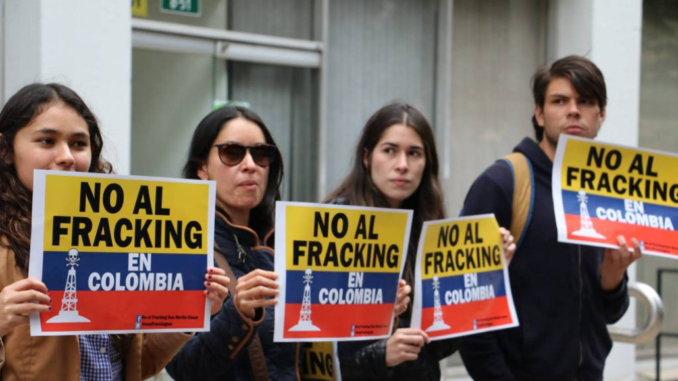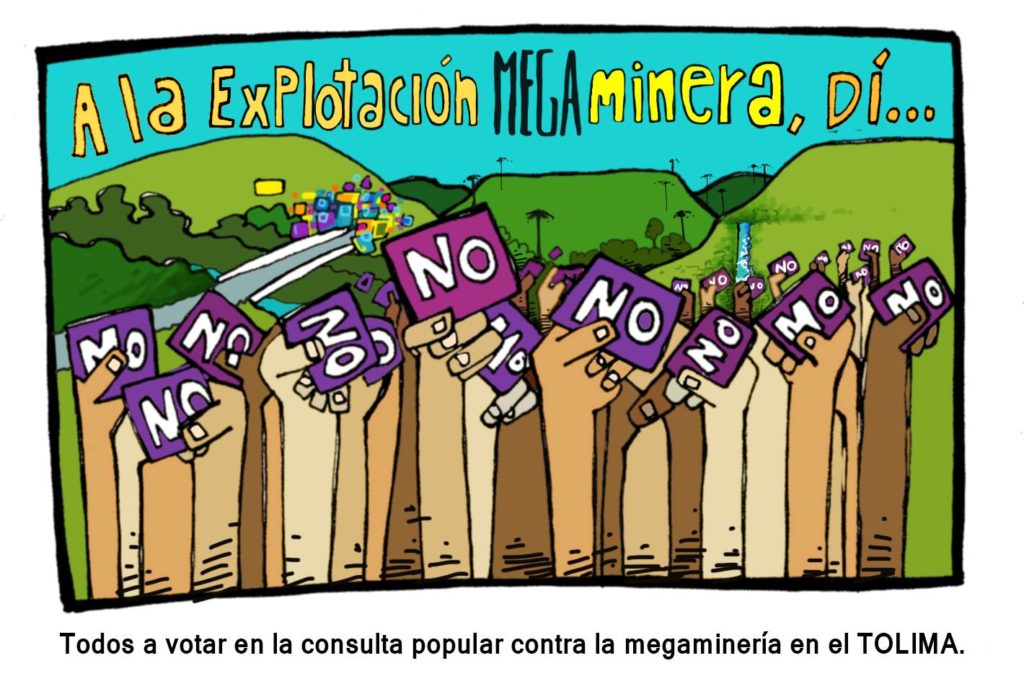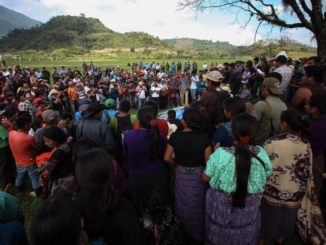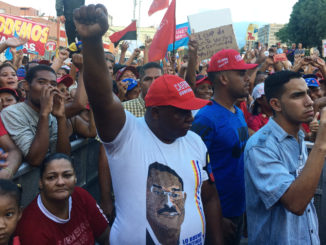
During the last few years, arguments have been put forward to defend the aggressive territorial occupation by oil companies, even in places with no extraction history. Throughout 2016, the importance of oil development in the post-conflict period was emphasized by both president Juan Manuel Santos and the management of Ecopetron and other companies, as well as the Ministry of Mines and Energy. However, during the last few months, the development of community initiatives has managed to stop some extractive projects by articulating different mobilizations, legal, advocacy, and communication strategies, thus thwarting the oil sector.
After the popular consultation in Cumaral–Meta, where, on June 4, 97% of voters decided to ban “seismic exploration, exploratory drilling, and hydrocarbon production activities” in their municipality, the debate became even more heated regarding local participation in deciding over matters related to the so-called Locomotora Minero–Energética (the “mining-energy locomotive”).1 On the same day of the consultation, the president of the Colombian Petroleum Association (ACP), Francisco José Lloreda Mera, disregarded the results, and even before he had stated that “the Colombian oil industry is seriously threatened.”
This article is intended to describe the different positions around peacebuilding in Colombia.
Extractivist Pax
During the II Congress of the Colombian Petroleum Association, which took place in the last week of September, 2016, at the time when the Peace Agreement between the government and the Revolutionary Armed Forces of Colombia (FARC) was signed, Francisco José Lloreda Mera pointed out that “the future of the country is intertwined with that of the [oil] industry” and the contribution made by the sector “is essential to ensure a stable and lasting peace.” In his presentation Hidrocarburos y paz: una ventana de oportunidad (Hydrocarbons and Peace: a Window of Opportunity) he stressed that the new, post-conflict economy must be “additional and complementary to, and not a replacement for, the oil economy.”2 His argument is based on the fact that the oil sector has been the financial support for the country’s fiscal sustainability. With the oil barrel at a price of up to 100 US dollars —between 2010 and 2014— and with production (extraction) peaks of up to one million barrels a day, the Colombian economy became dependent on mining-energy, particularly oil, revenues.
The interests of companies and governments which have bet on the extractivist pax are against the aspirations of wide sectors of the Colombian society who yearn for peace hoping to build a country on new democratic foundations and with greater social and environmental justice.
For Lloreda Mera, in “times of peace” goals should be more ambitious: production should double, or even quadruple, by extending exploration to new extractive frontiers, particularly off-shore and in the Amazonia, in order to increase reserves, since now they are enough for the next 5 or 6 years at the current extraction rate. And of course, this can only be achieved by improving conditions for investors. This is the thinking of the minister of Mines and Energy Germán Arce Zapata. He believes that “once peace is achieved, those conflict areas which are difficult to access will be places where hydrocarbon, mining, and energy projects will come true.”3
What has been stated by Lloreda Mera and Arce Zapata confirms the concerns of certain social sectors of the country, which have expressed that the Colombian government is not actually interested in overcoming the structural causes of the conflict, but in opening those areas to foreign investments. Maristella Svampa calls it “extractivist pax” and warns that, as it is conceived by dominant groups, “it would imply nothing but the radicalization of war through other means (higher criminalization, more environmental advocates being murdered, strengthening of the chain of violence).”4
The interests of companies and governments which have bet on the extractivist pax are against the aspirations of wide sectors of the Colombian society who yearn for peace hoping to build a country on new democratic foundations and with greater social and environmental justice. But it is not —and will not be— easy for them. This has been clear since 2015, as many municipalities have promoted and performed popular consultations and/or municipal agreements to stop the progress of extractive projects in their areas. Three of the consultations directly affect oil projects: Tauramena (Casanare), Cabrera (Cundinamarca), and Cumaral (Meta), which has resulted in a broad political and legal debate between communities, courts, environmentalists, businesspeople, and the national government. The truth is that the national government’s extractive project planned for the post-conflict economy is being threatened. The government has even refused to discuss this project with the insurgent groups, and is currently considering how to stop the rise of participatory democracy.
The extractive sector in the Colombian economy
Promoting a new extractive cycle for more than a decade has led to a dependence on the sector’s revenues. Uribe’s governments (2002–2006; 2006–2010) and Santos’ governments (2010–2014; 2014–2018, currently in office) have offered extensive benefits to foreign investors, which caused a rise of extractive projects, also favored by high oil and mineral prices during the early 21st century. Now the mining-energy sector accounts for 7% of the GDP and about 50% of exports. Until 2014, oil exports alone accounted for 52.79%, but in 2015 they decreased to 35.9% of the country’s total exports.5
In fact, the Extractive Industries Transparency Initiative (EITI Colombia) report carried out by the Ministry of Mines and Energy (2017) highlights that the decrease in the prices of oil and other minerals seriously affected the sector and represented a decrease in the country’s revenues from taxes and royalties. “Tax collection decreased by 34.8 %, and royalties collection, by 10.7 %,” which amounts to approximately USD 3 billion a year, while direct foreign investment decreased by 35% in 2015 in the hydrocarbons sector and 66.3% in the mining sector.6
In 2013, in a document prepared by the National Economic and Social Policy Council (CONPES), Conpes 3762: Lineamientos de Política para el desarrollo de Proyectos de Interés Nacional Estratégico (Pines) (Policy Guidelines for the Development of Strategic Projects of National Interest) the national government identified more than 250 investment projects of the transportation, energy and mining, and hydrocarbons sectors. Twenty one strategic initiatives were prioritized for the hydrocarbon sector: seven for exploration, one with five offshore blocks, five projects related to unconventional deposits, five production projects, one midstream project, and three downstream projects.7
The Strategic Projects of National Interest (Pines) are intended to reduce the number of procedures and processes for environmental licensing, acquisition of plots of land, and prior consultations. “Since 2015, Colombia’s National Hydrocarbons Agency (ANH) has made the oil companies’ investment commitments even more flexible. One of the favorable measures was to create project postponement conditions and to make it easier to go from a technical assessment contract to an exploration contract, allowing companies to avoid certain procedures and save time. In addition, the scheme of oil auctions or rounds which were performed every two years was replaced by a more flexible system by which companies can contract blocks with the ANH more often.”8 The rise of the extractive model not only favored companies, but also regional and national groups of power which have continued to offer guarantees to foreign investors.
Mobilization against the extractive model

The increase in extractive projects has exacerbated socio-environmental conflicts, and several territorial defense processes and a significant citizen mobilization were triggered. There may be two explanations. Firstly, the environmental crisis suffered by the territories, particularly where extractive projects have already been developed: Meta, Casanare, Guajira, and Cauca, which has set off the alarms about new projects. Secondly, the extension of the extractive frontier towards other territories has triggered concerns in locals, who have never imagined having projects of this nature, which even require using new, more aggressive technologies with a heavier consumption of energy, materials, and water, thus generating a growing concern in those territories.
Based on the map prepared by the Environmental Justice Organizations, Liabilities and Trade (EJOLT) project, more than 115 socio-environmental conflicts have been recorded in Colombia, most of them due to extractive projects. The database of the Center for Research and Popular Education (CINEP) has also warned about the socio-environmental conflicts that are becoming increasingly important, now accounting for 30% of the cases recorded in the country. This confirms that mobilization for socio-environmental justice has been growing, with important victories achieved. An example of this is that all the popular consultations that have been made have been won9 and the use of citizen participation mechanisms rose over the past year, with more than 40 being processed, in addition to popular initiatives. On the other hand, municipal authorities and councils have made municipal agreements to prohibit extractive projects in the municipalities of Antioquia, Huila, and Caquetá.
The government and companies have tried to disregard the results of these consultations, while, on the other hand, the environmental policy action has managed to spark off an important national debate, which has received interesting responses from the high courts. In August 2016, the Constitutional Court issued the ruling T-445-16 by which it ratified the territorial entities’ sovereign decision to regulate the use of land and ensure environmental protection, “even if exercising such prerogative leads to prohibiting the mining activity.”10 This decision was ratified in the first week of June by the Council of State.
The growing mobilization for environmental justice is certainly questioning the government’s current extractive model, which represents the notion of peace it tried to impose through the peace agreement signed with the FARC. This mobilization has invigorated numerous sectors of the country, including environmentalists, workers, educators, farmers, indigenous people, Afro-Colombians, who spoke out on June 2nd, when more than 200,000 people in cities such as Ibagué, Bucaramanga, Bogotá, and Armenia, and over 25 municipalities in Tolima, Caquetá, Quindío, Meta, and Santander, joined the IX Carnival Parade in Defense of Water, Life, and Territory. This year not only the victory of Cajamarca’s popular consultation was celebrated, but Cumaral’s consultation, two days later, received wide support. The conflict between the extractivist pax and peace with social and environmental justice is sharp. We have yet to see how things turn out.
A tailor made fast-track for companies
The heavy dependence on oil revenues has led the government to grant more and more privileges to foreign companies. On May 26th, the president of the Republic issued Legislative Decree No. 883 modifying tax reform Act 1819/2016, to include mining, hydrocarbon exploitation, and port companies —major taxpayers— in the benefits laid down in such law. This Decree-Law authorizes companies of said sectors “to pay up to 50% of the income tax and complementary taxes, by allocating this value to direct investment in executing socially significant priority and feasible projects in different municipalities located in the Zones Most Affected by the Armed Conflict (ZOMACs), which have been approved by the Territory Renewal Agency (ART) and the National Planning Department (DNP).”11
This decree is part of another series of measures, called “fast-track,”12 intended to facilitate and ensure the implementation and regulatory development of the Agreement between the national government and the Revolutionary Armed Forces of Colombia. The government’s argument is based on the connection with Point 1 of the Final Agreement, which stresses “the relevance of investments in road, irrigation and drainage, electricity and connectivity, and healthcare infrastructure,” and Section 1.2, which “points out that in the zones affected by the conflict, a structural transformation of the rural area and sector and a fair relationship between the rural and the urban areas must be achieved. To this end, among other goals, development and integration of the regions which have been abandoned and struck by the conflict must be ensured, by implementing progressive public investments.”13
Or, to put it in different terms, the government would be using extraordinary powers to disregard the Congress decision made by late 2016, in order to grant benefits to foreign investors. This is because no additional payment is being generated by the companies, but they are being enabled to pay up to 50% of the income tax and complementary taxes by allocating that money to executing works in the ZOMACs, money which should flow into the state’s coffers. In other words, functions of collection and execution of public funds coming from taxes are being delegated to private companies.
This article was originally published at Observatorio Petrolero Sur. Translated and published with permission.
End Notes:
[1] Author’s note: This is how Juan Manuel Santos’ government called a massive exploitation project for mining deposits and energy developments as the backbone of his plan to boost the economy of the country.
[2] Lloreda Mera, F 2016, Hidrocarburos y paz: una ventana de oportunidad, in II Congreso de la Asociación Colombiana del Petróleo, September 26, Bogotá. Viewed in http://www.congresoacp.com/congreso2016/images/apertura/intervencion__congreso_acp2016_.pdf
[3] Portafolio 2016, Los retos de la economía tras el fin del conflicto, August 24, Bogotá. Viewed in http://www.portafolio.co/economia/retos-dela-economia-colombiana-tras-el-acuerdo-depaz- 499846
[4] Svampa, M 2017, “Prólogo,” in Roa Avendaño, T et al (Coord.) 2017, Como el agua y el aceite, Conflictos socioambientales por la extracción petrolera, Censat Agua Viva, Bogotá.
[5] Ministerio de Minas y Energía (MME) 2017, Informe Eiti Colombia, Vigencias fiscales 2014 y 2015, Government of Colombia, Bogotá, pp. 22-23
[6] Ibid., p. 11.
[7] Ibid., p. 54
[8] Roa Avendaño, T et al (Coord.) 2017, Como el agua y el aceite, Conflictos socioambientales por la extracción petrolera, Censat Agua Viva, Bogotá.
[9] Author’s note: Since 2015 seven popular consultations have been performed, two of which prohibit hydrocarbon projects (Tauramena-Casanare and Cumaral-Meta), four prohibiting mining projects (Piedras, Cajamarca-Tolima, Arbeláez-Cundinamarca, and Pijao-Quindío), and one in Cabrera (Cundinamarca) which prohibits any type of mining-extractive projects.
[10] Corte Constitucional 2016, Sentencia T-445-16, Bogotá./ — (2017). Sentencia T-622-16, Bogotá.
[11] Voces por Colombia 2017, citizen intervention on the occasion of the automatic review of constitutionality of Decree-Law no. 883 dated May 26, 2017, “by which Act 1819 of 2016 is modified in order to include mining and hydrocarbon exploitation companies so that they can pay taxes by means of works”. Unpublished.
[12] Author’s note: In order to enter into or put into practice the peace agreement signed by the Colombian government and the FARC, a number of laws and constitutional reforms are required. Therefore, through a legislative act (No. 1 of 2016), the “fast track” was established. This is a mechanism which reduces the number of debates in Congress to approve laws and constitutional reforms, and confers extraordinary and exceptional legislative powers to the President. The decree’s term period is 180 days after the Legislative Act effective date.
[13] Ministerio de Hacienda y Crédito Público 2017, Decreto Ley 883, Government of Colombia, May 26, Bogotá.
[14] Voces por Colombia 2017.



